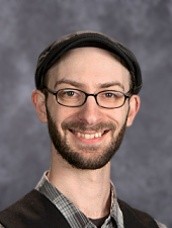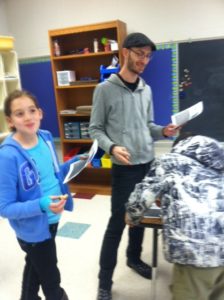 This January 10th, ENGAGE! An Evening of Jewish Learning hosts an array of powerfully good Twin Cities teachers including artist and scribe D. Marcos Vital. His class, “Spandex? And Yarmulkes? Oy! What Comics Say About Jews and Jews Say Through Comics” will look at the role of Jews in American comic production and explore the styles and politics of this subversive medium.
This January 10th, ENGAGE! An Evening of Jewish Learning hosts an array of powerfully good Twin Cities teachers including artist and scribe D. Marcos Vital. His class, “Spandex? And Yarmulkes? Oy! What Comics Say About Jews and Jews Say Through Comics” will look at the role of Jews in American comic production and explore the styles and politics of this subversive medium.
Vital grew up in St. Paul, drawing dinosaurs and comics. He has matured into a man who still draws dinosaurs and comics. In the meantime, he became a scribe, writing and restoring Torahs, and making and teaching Jewish text and art. He received a BA in Jewish Studies at the U of M and received an MA in Art History at the Jewish Theological Seminary, and despite having lived in Brooklyn, he thinks he’s not a hipster.
Beth Friend, co-chief of ENGAGE! wanted to know a bit more.
Beth Friend: When did your love of comics begin?
D. Marcos Vital: It’s interesting to me that something so classically nerdy often begins as a social phenomenon. In high school I drew comics in art class and was part of a comics and anime club with friends. In college, I made a lot of friends who coincidentally also liked comics, and we took road trips to comic conventions together. We’re still friends, and we still talk about comics. Who knows if my appreciation would have blossomed in the same way without that social aspect, even though I love comics as an art form.
BF: What was the appeal?
DMV: I have always related to comics as a mode of expression: like many people, I think in pictures and words. And I draw. A lot. So that comes with a positive (and negative) jealousy: I love reading them and I want to make them. That makes me want to read more and see great artists and writers showing and telling amazing and multi-faceted stories.
BF: And who were your favorite characters?
DMV: My favorites as a kid were, of course, mostly of the spandex and caped variety. I loved Batman, X-Men, and Spider-Man. I identified most with the latter because I really wanted his powers, and as a nerdy kid, shared plenty of his neuroses. Artistically, I was most inspired by certain Batman and Spider-Man artists, and manga (Japanese comics) such as Akira.
 BF: And how – as you got older – did your appreciation of image and written text change?
BF: And how – as you got older – did your appreciation of image and written text change?
DMV: It became more nuanced, in that my tastes grew with me. I began reading a greater variety of comics that opened me to more diverse artistic and literary approaches in the medium (reading independent and less popular mainstream comics). I also began reading things about comics that I had never previously encountered — like Scott McCloud’s Understanding Comics — that grew my appreciation of the complexity and history of the art form.
BF: Tell us about becoming a sofer (religious scribe) What is the nature of that experience for you?
DMV: Since childhood, I have balanced some very disparate but deep interests: art/illustration, science, and Jewish learning. When the chance to train as a scribe came about after college, I took the opportunity and moved to NYC. I immediately began learning how to restore Torah scrolls, and it was a very consuming and fulfilling enterprise. In some ways, safrut (scribal arts) combines aspects of all my interests: it’s a detailed art form, focused on Jewish communal education and service, and requires intense intellectual inquiry.
But let me also hint at the deep work of writing or restoring a scroll: I know that my work will be read by many, many people for many, many years: families, b’nei mitzvah, rabbis, the learned, the unsure, people who seek, and people who are content. And my work is completely anonymous. It is the work itself – part of an intergenerational communal fabric – that I leave behind. Each moment, my work as a sofer transcends me.
BF: You’ve been teaching a class on Jewish comics to kids at Talmud Torah of St. Paul. What have their reactions been?
DMV: Younger kids who grew up with the internet have such a cultural diversity at their fingertips, and it shows: they are growing up in a world in which comics were part of a rich and shared cultural landscape. It’s not just nerds who like comics now. One benefit, therefore, is that a conversation about comics with kids doesn’t need to validate comics as an art.
Concerning the Jewish aspect, many of the kids have already encountered pieces of the Jewish connection to comics (it’s a popular historical narrative). This class is part art class and part art history, so my goal is to facilitate their ability to tell their own narrative through image and text, while placing it within the history of Jewish visual stories. As the class progresses, I’m interested in helping them identify Jewishness in comics, or articulate a disagreement with those who see it as an undercurrent.
BF: You’re about to become a father for the first time and you’ve got a busy working life. Is there still time for you to take pen in hand?
DMV: The short answer is that I cannot stop drawing and calligraphing. But, as most artists will readily tell you with a smile: No, there is no time. Nonetheless, I restore scrolls, make ketubot, practice drawing and illustration, and I am very slowly working on my own comic(s). It’s hard to describe, but making art is like a part of my body, like my right arm itself: I’m not always mindful of it, but it is my right arm.
EVENT: ENGAGE! An Evening of Jewish Learning
DATE: Saturday, January 10, 2015 at 7 pm
LOCATION: Talmud Torah of St. Paul, 768 Hamline Avenue South, St. Paul, MN 55116
Cost: Under 30: FREE Above: $18.
To check out all our classes and to register: stpauljcc.org
After classes, we chill the chill with live music, Sebastian Joe’s ice cream and drinks. For more information contact Beth Friend at [email protected] or Sara Lynn Newberger at [email protected].

